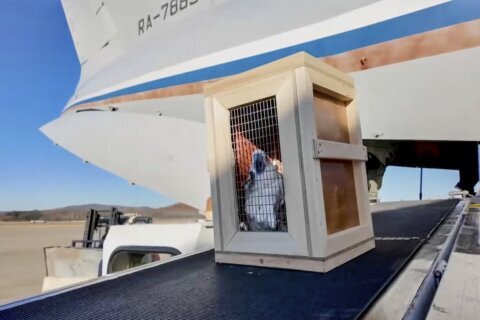LELILEF SAWAI, Indonesia (AP) — On a steep trek up to his forest farm on the Indonesian island of Halmahera, Librek Loha let out a cry of dismay. “Aduuuuh,” he said, his voice trailing off.
“Landslides, again. They happen all the time now.”
The mudslide below Loha´s plantings of cacao, nutmeg and pineapple have exposed more orange, rocky soil — adding to miles of bulldozed forest and river that are leaving the farm an island of green amid red-brown. Where trees once grew, there are dusty warehouses, mountains of black coal and water that runs silty brown.
This region of Weda Bay is now one of the world’s largest nickel production facilities. Fiery smelters and multiple coal-fired power plants burn nonstop to refine nickel ore into material for batteries and steel.
Indonesia aims to dominate the world’s nickel supply, and it’s succeeding. The country has gone from having two nickel smelters to 27 over the last 10 years, with 22 more planned, according to S&P Global Commodity Insights. Last year, the country was responsible for more than half the supply of nickel ore globally. The metal was once known mainly for making stainless steel; now demand has skyrocketed as automakers like Tesla need it for electric vehicle batteries and companies that make larger batteries need it for clean electricity projects.
But where developers build out these vast nickel-processing plants, surrounding forest disappears twice as fast, according to a new analysis by the Indonesian nonprofit Auriga.
Indonesia has the largest reserves of nickel in the world. Until recently, it mostly sold its nickel deposits — ore — raw. It didn’t have the processing plants to refine the metal.
Then 10 years ago, Indonesian officials decided the country should stop selling its resources so cheaply and instead refine them, to provide employment and fetch higher prices. A massive nickel buildout ensued. President Joko Widodo has bolstered this, co-locating nickel smelters with EV battery factories.
In addition to the new smelters, coal power plants have sprung up to serve the miles of new industrial parks. Surrounding villages can see the well-lit nickel works while they live through regular power outages.
Indonesia’s nickel ore lies in shallow deposits, easily accessible when the rainforest is cut down.
The new analysis of rainforest loss, based on government data, shows deforestation rose from an average of 33 square kilometers (about 13 square miles) around each smelter, to 63 square kilometers (about 24.5 square miles). If all 22 new plants are built, deforestation is likely to increase dramatically.
“The damage to the environment is devastating,” said Timer Manurung, chairman of Auriga. “Deforestation has significantly increased … rivers are polluted, mangroves are cut to develop smelter areas, coastal areas and coral are being damaged by the smelters.”
The waste from coal power plants was another problem, he said. The Associated Press verified the methodology used in the Auriga report.
A vast tropical archipelago, Indonesia is the world’s third most rainforest-covered country, home to giant forest flowers and endangered orangutans and elephants.
Since 1950, more than 740,000 square kilometers (more than 285,000 square miles) of Indonesian rainforest — an area twice the size of Germany — have been logged, burned or degraded, according to Global Forest Watch.
In Lelilef Sawai, the village now surrounded by the Weda Bay Industrial Park, the deforestation and its impact are evident. Loha, the farmer, has held out, refusing to sell the land he’s tended for four decades. Now orange dust often covers his plants and clean water is scarce. The plants also grow more slowly, he said.
From his land, he can hear construction and see bright orange sediment flow into the sea. Research shows landslides are far more likely in deforested areas.
Max Sigoro, 54, a traditional hunter and farmer, echoes Loha. Bright lights and noise from construction repel the deer he used to hunt at night. He says he’s lost nearly all his previous income since the industrial park’s expansion.
Abdullah Ambar, 61, says the sea near the project has become murky and he can’t fish anymore; the fish are gone.
PT Indonesia Weda Bay officials declined to be interviewed by the AP but the company said in statement it has planted more than 10 square kilometers (about 4 square miles) of new trees. The company plays an active role in supporting the living standards of local people, offering economic development, it said, and the industrial zone meets all environmental standards. The company said it strives to protect water and has launched coral and mangrove planting programs.
Complaints from villagers at the Weda Bay project mirror those from communities near other smelter works across Indonesia, including a controversial industrial park on the island of Borneo and other projects in North Maluku.
Perhaps related to these complaints, the interest of some European companies in nickel from Indonesia may be cooling.
In recent weeks, the French mining company Eramet and German chemical giant BASF announced they were canceling plans to build a $2.6 billion nickel refinery. Eramet cited no reason, while BASF blamed changes in the global nickel market. The announcements came shortly after being contacted by the AP for this story.
Indonesia has been wooing Tesla, which uses twice as much metal in its total production of batteries than the next highest auto competitor. The amount of nickel it used in 2023 was up a third over the year before. Only 13% came from Indonesia last year, but its 2023 impact report mentioned Indonesia 18 times and warned the country’s nickel will be crucial.
Tesla did not respond to emailed questions asking about its use of nickel from Indonesia and deforestation.
Questions to Indonesia’s Ministry of Environment and Forestry, Coordinating Ministry of Maritime and Investment Affairs and Ministry of Energy and Natural Resources went unanswered.
Nickel-making doesn’t have to be dirty. Using clean energy rather than coal goes a long way toward cleaning the air near nickel complexes. The cleanest operations produce emissions vastly below the industry average, according to a report by the nonprofit Transport and Environment last year. Automakers could do more to investigate where their nickel comes from, including using satellites, and ban nickel from deforested areas.
But for villagers like Loha, Sigoro and Ambar, the prosperity they were led to believe would come, has not come.
“Now our water is dirty and the fish and animals we hunt are gone,” Ambar said. “Where is the better life promised?”
___
Davey reported from London and Fassett reported from San Francisco. Associated Press photographer Achmad Ibrahim contributed to this report.
___
The Associated Press’ climate and environmental coverage receives financial support from multiple private foundations. AP is solely responsible for all content. Find AP’s standards for working with philanthropies, a list of supporters and funded coverage areas at AP.org.
Copyright © 2024 The Associated Press. All rights reserved. This material may not be published, broadcast, written or redistributed.






